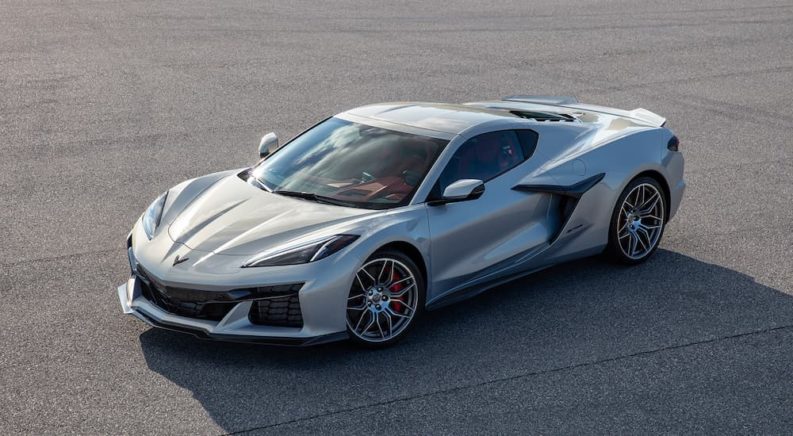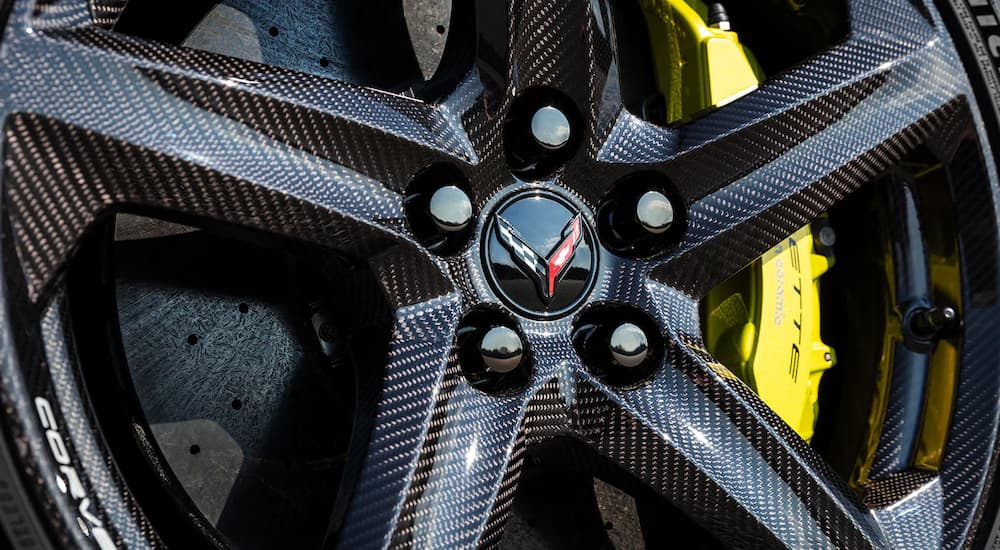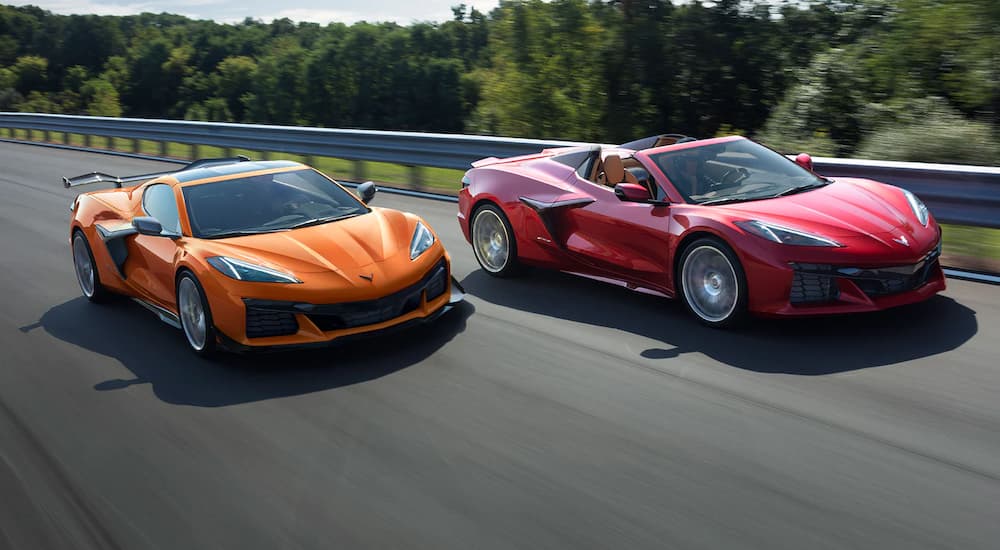It might be the most anticipated sports car of 2023––the car that permanently lays to rest the idea that a Corvette is a poor man’s Ferrari. With a mid-engine layout, the most powerful naturally aspirated V8 engine in a production car (ever), and a flat-plane-crank design that redlines at 8600 RPM, the 2023 Chevy Corvette Z06 is a side-by-side competitor with Maranello’s best. It actually holds advantages in that fight––it’s far cheaper than any Ferrari yet remains almost as customizable, is serviceable at hundreds if not thousands of easily-accessed dealers nationwide, and is straight-up quicker than a Roma, Portofino, or F8.
Much ado has been made about the engine, for good reason. Its 670 hp is unmatched by any naturally-aspirated production V8––the closest rival is the Mercedes-Benz SLS AMG Black Series at 622 hp––and the unearthly howl it makes as it rips to the redline is a centerpiece of the Z06 experience. Designed exclusively for this car, the LT6 engine shares nothing but its 4.4″ center-to-center bore spacing with the traditional Chevy small block that it replaces, and it’s already cemented itself as a legend before production has even begun. However, the LT6 is far from the only significant engineering achievement that makes the Z06 more of a race car than it’s ever been before.
It’s a Road Car! It’s a Race Car! It’s a Z06!
While the powertrain is the noisiest highlight of the 2023 Corvette Z06, it is far from the only noticeable deviation from the regular Stingray. In fact, the Z06 is closer in appearance to the C8.R GT race car because it shares many of the aerodynamic elements engineered for improved grip, slip, and cooling characteristics! If you approached a Stingray and Z06 standing side by side, you’d immediately notice the wider stance of the Z06––by 3.6″––and you’ll see differences in the front fascia and side panels that allow for more effective air handling on the Z06. Depending on the options, it might look more like a fighter jet than a car, complete with canards and a massive carbon-fiber wing! Even the rear fascia is obviously transformed, with the highlight being the center-mounted quadruple exhaust tips designed to reflect engine noise into the cabin.
None of these changes are purely for style (save for the exhaust, which was entirely redesigned specifically to achieve a hair-raising aural experience). Many of them are inherited directly from the function-first C8.R! Automotive enthusiasts are well-aware of the fact that developments on the track lead to developments on the road. With two successful years of racing under their belts, the Corvette Racing team is in an excellent position to lend its experience to the Z06. The outcome is a car that, in the words of five-times Le Mans GT class winner Oliver Gavin, is “fundamentally a race car that you can drive on the road. The ability to carve the corners, the ability to put that traction down––all those feelings that I had from the race car [are] right here.”
Super Tech to Design an American Supercar
The aerodynamics of the Corvette Z06 began development far from the hills and hairpins of the Nürburgring. As with almost any modern vehicle, it started with scale clay models and computational fluid dynamics (CFD), where minute adjustments can be made and studied several times per hour to see how they impact the look and aerodynamic behavior of the car. CFD is essentially a wind tunnel simulation technique, allowing the design to be rapidly evaluated with no physical test equipment, thanks to advanced engineering models and extreme computing power. Corvette Magazine reported that for the C8.R, components were refined both individually and as part of the assembled vehicle using these techniques. With CFD, it’s relatively easy to visualize the high and low-pressure points across a surface, detect flow separation (a significant contributor to drag), validate sufficient airflow through essential intakes, and calculate downforce across the vehicle.
The brilliance of sports car design is the stylization of functional components to improve the performance and appearance of the car. Corvette executive chief engineer Tadge Jeuchter told an audience at the Corvette Museum that the C8 Stingray’s engine intake was swept so far forward and down-facing for a multitude of reasons:
- Mitigate water intake in rainy conditions.
- Mitigate stone impacts––also a function of the rocker.
- Mask the door handle with an unpainted contact surface while providing a cool visual accent.
As designers adjusted the specifics of this design feature, its performance could then be quickly evaluated using CFD, leading to further iterations to optimize flow and effectiveness based on these simulations. Not only could they ensure that it looked great, but they could also instantly validate whether or not it performed well! This is essential for race car development, as we’ve far surpassed the point where “optimization” can be performed by the naked eye. Designing with objectives that are constantly at odds with each other––features that provide a lot of downforce, for instance, are also notorious for increasing drag––the ability to quickly work towards optimized designs is key.
The Corvette Racing team has another tool to work with––a highly advanced driving simulator called driver-in-the-loop (DIL), with a massive 180-degree wrap-around screen and a cockpit with several axes of rotation to provide the ultimate racing simulator. The C8.R is the first race car developed with this simulator, which essentially allows a driver to pilot the car before a working physical model ever exists by combining the best of virtual reality systems, CFD, and existing high-quality driving simulators. Fearlessly pushing a design past its limits, trying a crazy idea that would be prohibitively expensive to build, simply familiarizing oneself with a new track and design––all becomes possible with the DIL.
The Bridge from Road to Track is an Aero Pack
The Z06 naturally inherits a lot of aerodynamic features from the C8.R body that it shares, while the optional aero kit (standard with the Z07 Performance package) draws even further inspiration from the race car. Let’s start at the front, where the most obvious change is the fascia––the openings are larger than the Stingray’s, and every one now has a radiator behind it. The massive central radiator is the primary source of engine cooling, while the two flanking radiators augment that cooling power. Radiators mounted on the sides of the car add a little extra chill to some of the coolant returning towards the engine for a total of five cooling units, which ensures the engine and transmission run smoothly even at the limit!
The entire configuration is a revelation for Corvette design, with the new engine location behind the driver freeing engineers to do whatever they wanted with the front diffuser and air channeling designs. The air blasting in through the front slips out onto the windshield and right behind the front wheels, minimizing drag and maximizing cooling in a way that was completely impossible when the engine was in the front.
Beneath the fascia intakes, and available in weight-saving carbon fiber, are a splitter, underwing, and canards––all intended to keep the front end planted firmly on the ground. An interesting detail shared by Chevy Communications rep Trevor Thompkins with MotorTrend is that the underwing comes with a “stall gurney”––this allows the car to be quickly modified for improved road or track driving by stalling airflow across the underwing when installed (reducing drag on the road) or allowing free flow when removed (maximizing downforce on the track).
Unseen are the underbody strakes––essentially little guides that direct air that flows below the car for precise control and improved stability––which leads us to the back, where the base Z06 has a rear spoiler and a wicker bill attachment (which basically makes the spoiler taller when installed). Without the stall gurney and with the wicker bill, the Z06 generates 365 lbs more downforce at top speed than it would otherwise; or you can swap the configuration for more civilized driving with greater efficiency.
Along the sides, ground effects shield the intakes from stones as mentioned above but also serve an aerodynamic purpose, helping to guide airflow into the maws of the intakes. The additional 1.5” of width on either side of the Z06 is applied to maximize intake volume. Here a significant departure from the C8.R is that the Z06 does not feature a centrally-mounted intake, which would partially obstruct rear visibility. As a result, the side intakes are responsible for a larger share of breathing and cooling duties on the Z06 than on the race car, making their size even more important.
However, the piece de resistance of any Z06––visually, at least––is the gigantic carbon-fiber rear wing that replaces the spoiler when the aero kit is applied. Give it the right paint job, and you’ll have many drivers confuse the Z06 for the C8.R with this wing in place. Serious track drivers will love the benefits of the wing, which elevates maximum downforce up to 734 lbs at 186 mph––double what the car makes with the wicker bill and more than any Corvette before it at that speed.
State-Of-The-Art Road Jet
There’s a lot to be excited about with the 2023 Chevy Corvette Z06. Chevy made a launch video that was actually fun to watch, went further than ever before to make the once-secretive performance package as close to the race car as legally possible, and focused design efforts not on making the Z06 a raw performer but an inescapable experience. The reveal emphasizes this––the engine’s unique howl is never far from our ears, and the talk is more about the design process and significance of the car than the sheer numbers.
That’s what puts the 2023 Chevy Corvette Z06 on my shortlist for car of the year. You can have insane acceleration numbers (0-60 mph in 2.6 seconds) and stronger-than-gravity roadholding (1.22 g). Your car can have the fattest tires, the coldest engine, the quickest transmission, or the lightest body. But it’s meaningless to me if the car loses character in the pursuit of perfection. Most of us will only ever experience a Z06 by seeing it on a dealer lot, hearing it on the road, or (if we’re lucky) sitting in the passenger seat. A tenth of a second or 100 lbs of downforce on its own means nothing to me––achieving that with a personality to send a shiver down my spine means everything.






